Unverified narratives about virus origins spread from fringe to mainstream in U.S.
Infodemic worsens as unverified claims about
Unverified narratives about virus origins spread from fringe to mainstream in U.S.

Infodemic worsens as unverified claims about COVID-19 origins dominate media coverage via primary influencers
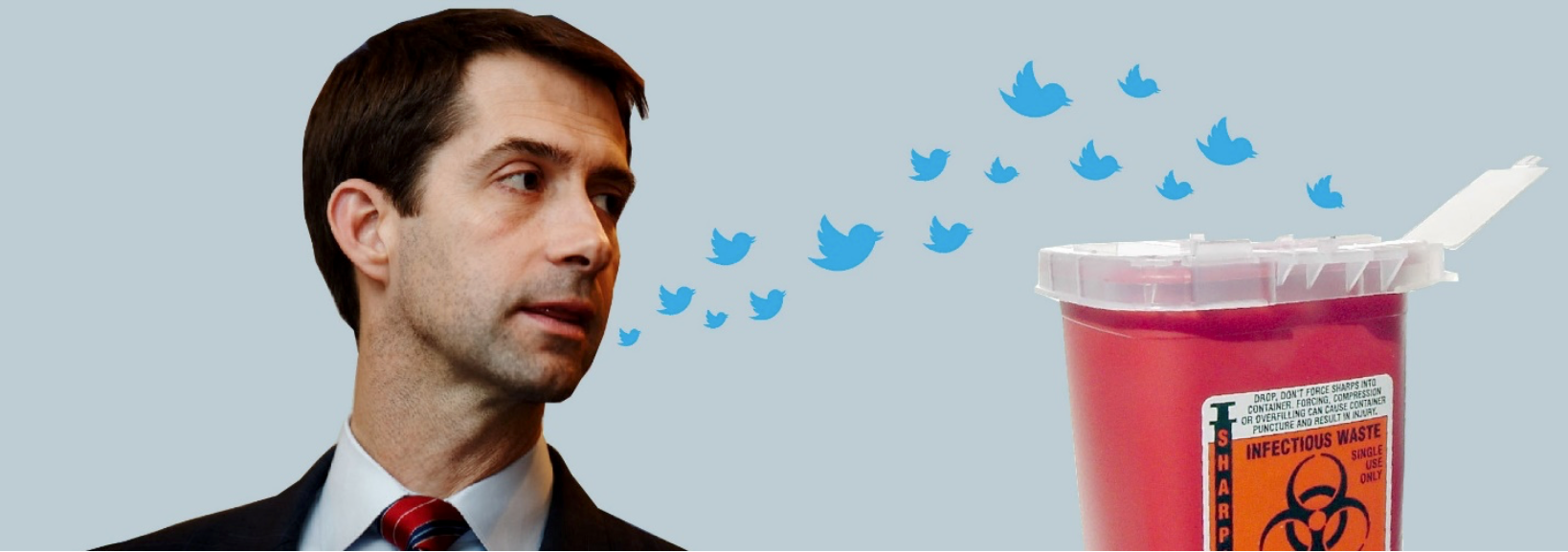
U.S. Senator Tom Cotton has continuously amplified the narrative that the novel coronavirus (COVID-19), which has claimed the lives of around 2,870 people as of February 28, 2020, may have originated in a biosafety lab in Wuhan: a theory that has been “strongly condemned” by scientists closely studying the virus outbreak.
The World Health Organization (WHO) describes the spread of damaging online information as an infodemic, a false information virus that spreads faster than a real virus does. Disinformation, misinformation, and incomplete information can spread via influencers and media amplification far more quickly than a virus can spread from one person to another. With over 208,000 Twitter followers and over 159,000 Facebook followers, as well as being a frequent guest on cable television where he made this claim, Cotton has the ability to spread his ideas to hundreds of thousands of people, who in turn spread the ideas further.
The theory that the virus started in the Wuhan lab has been picked up primarily by fringe sites and social media pages dedicated to conspiracy theories and further amplified by people with large public profiles online, such as Cotton. Cotton, who has fought to curb China’s relationship with the United States since being elected to the Senate in 2015, has been criticized for playing fast and loose with facts about the novel coronavirus. Even Fox News referred to Cotton’s unverified claims as “startling.” As an influential and outspoken public figure, his statements on the origin of the novel coronavirus hold weight, and his verified status on Twitter lends him a degree of authority that the average user might not have. The DFRLab tracked the origin of the conspiracy theory to see where the theory originated, where it spread, and which groups or individuals amplified the narrative.
The Wuhan lab and unsupported claims around it
In January 2018, China opened the country’s first level-four biosafety laboratory (BSL4-Lab). Located in Wuhan, the lab has the authority to experiment with easily transmitted deadly pathogens such as Ebola and coronaviruses. In order to operate at the highest level of biocontainment, the lab filters its air and purifies waste before it exits the testing space. Researchers are also required to change their clothing and shower before and after using the facility.
As a result of its proximity to the epicenter of the origin of the novel coronavirus, rumors have spread online that the virus may have been released or escaped from the lab itself. These rumors have been amplified by Cotton, who has repeatedly mentioned the BSL4-Lab in relation to the novel coronavirus in interviews and in official Senate convenings, suggesting that the virus may have originated in the lab. His tweet amplifying the conspiracy was retweeted more than 2,000 times and liked 3,800 times.
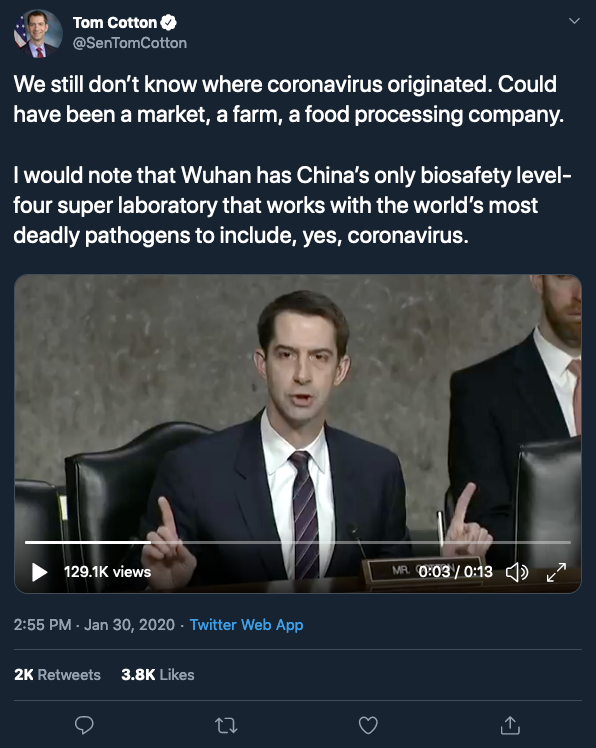
A timeline of the lab and the novel coronavirus outbreak
According to a DFRLab query using Brandwatch, the first time the biosafety laboratory was mentioned in relation to the COVID-19 outbreak in English on Twitter was January 4, with two tweets that garnered little attention. Both tweets highlighted the lab’s location in Wuhan, implying there may be a correlation between the lab and the outbreak.
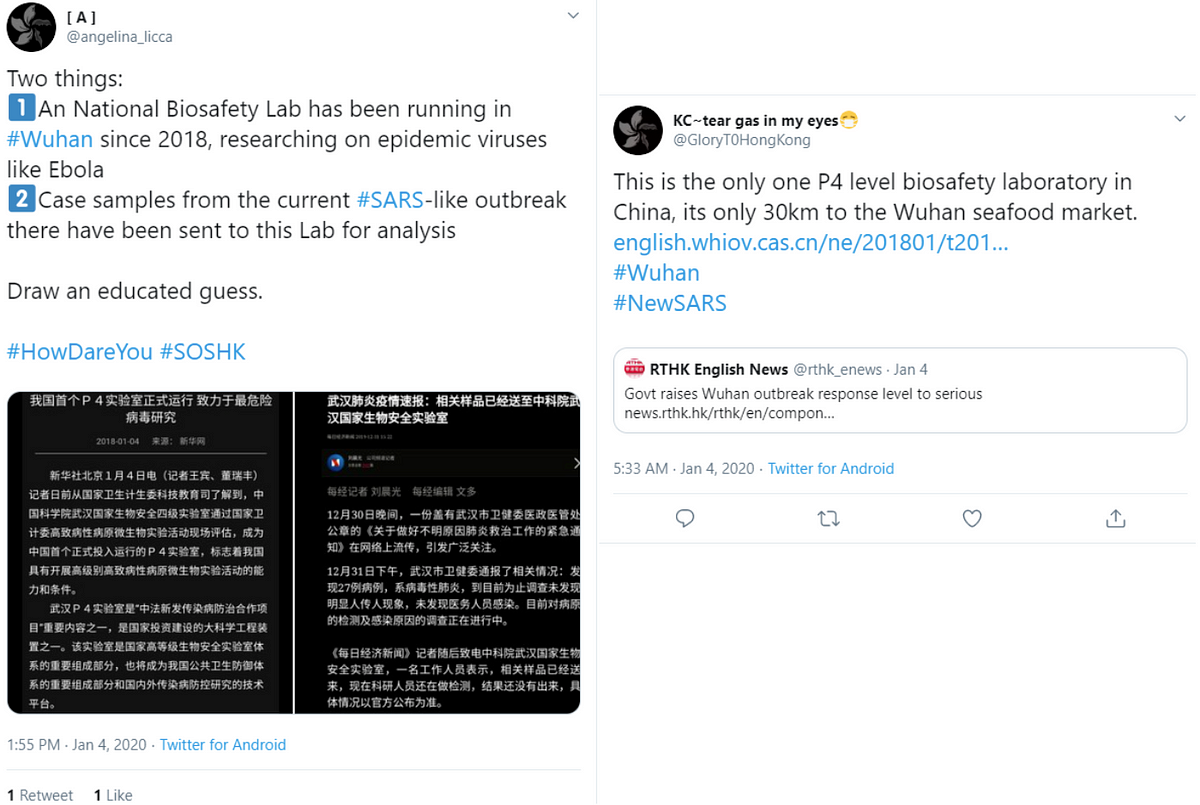
The following day, another Twitter user used the hashtag #ChinesePneumonia in a post about the Wuhan biosafety lab. Comments on the tweet referred to China as “terrorist” and “Nazi.” Although the post was only retweeted 82 times, it potentially reached over 23,500 Twitter users.
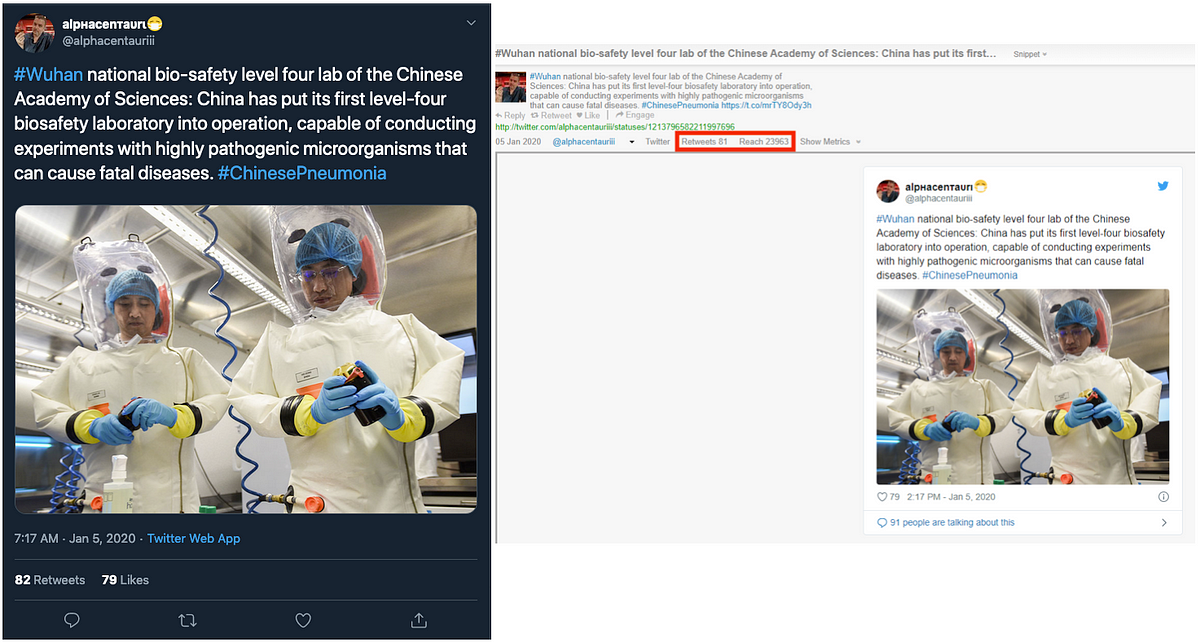
After the first set of tweets in the beginning of January, little mention of the lab cropped up on social media until January 21, when a video allegedly of the lab itself was posted to Twitter. The clip, which was originally uploaded to TikTok and copied to Twitter, was viewed over 90,000 times and retweeted over 400 times. Comments from Chinese Twitter users — made from outside China or via workarounds, given it bans direct access to the platform domestically — criticized the ruling party, suggesting the lab was used to create bioweapons and test them on the Chinese population.
In the following days, mentions of the lab on social media, blogs, and websites spiked considerably. Many of these posts linked to an article about the creation of the lab published in 2017 by Nature, one of the world’s top scientific journals. The piece claimed that some scientists were worried about pathogens escaping the new laboratory, and also questioned the addition of the high-level lab when geopolitical tensions were high. It also stated, however, that the creation of multiple BSL-4 labs in Europe and the United States had also met with resistance from the scientific community.
Although the article raised valid concerns from the scientific community, the information was so distorted by COVID-19 conspiracy theorists that the journal’s editor added a note in January stating Nature did not know of any evidence linking the lab to the coronavirus outbreak.
On January 22, a screenshot of the article — edited to emphasize location and lacking any context beyond the location — was posted to a subreddit dedicated to conspiracy theories. The post was upvoted over 5,000 times, with users commenting that the novel coronavirus had been created by the Chinese government and tested on its citizens.
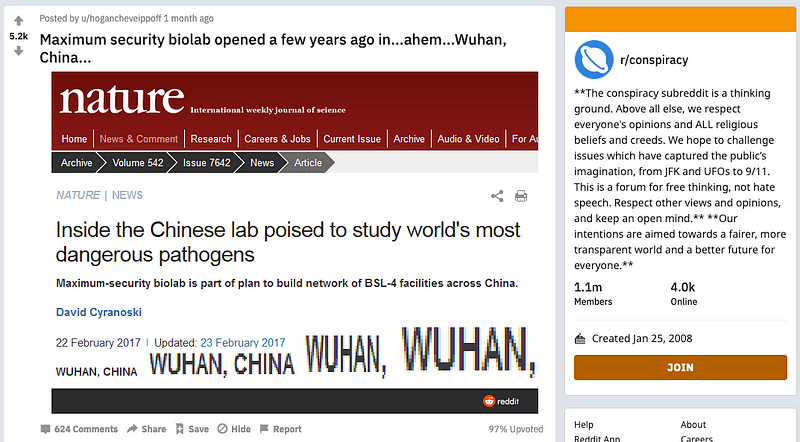
Then, on January 23, British tabloid The Daily Mail ran an article titled “China built a lab to study SARS and Ebola in Wuhan — and U.S. biosafety experts warned in 2017 that a virus could ‘escape’ the facility that’s become key in fighting the outbreak.” The piece took much of the content from the Nature article and drew a correlation between the location of the lab and the current outbreak without providing any actual evidence.
According to a CrowdTangle readout, the Daily Mail article was shared to Facebook pages and groups that promote non-traditional medical cures, anti-vaccination rhetoric, and pro-Hong Kong democracy pages. Many of the comments on the article shared to these pages stated that the virus was a bioweapon, that it originated in the lab, and that China created it with the intention of infecting hundreds of thousands of people.
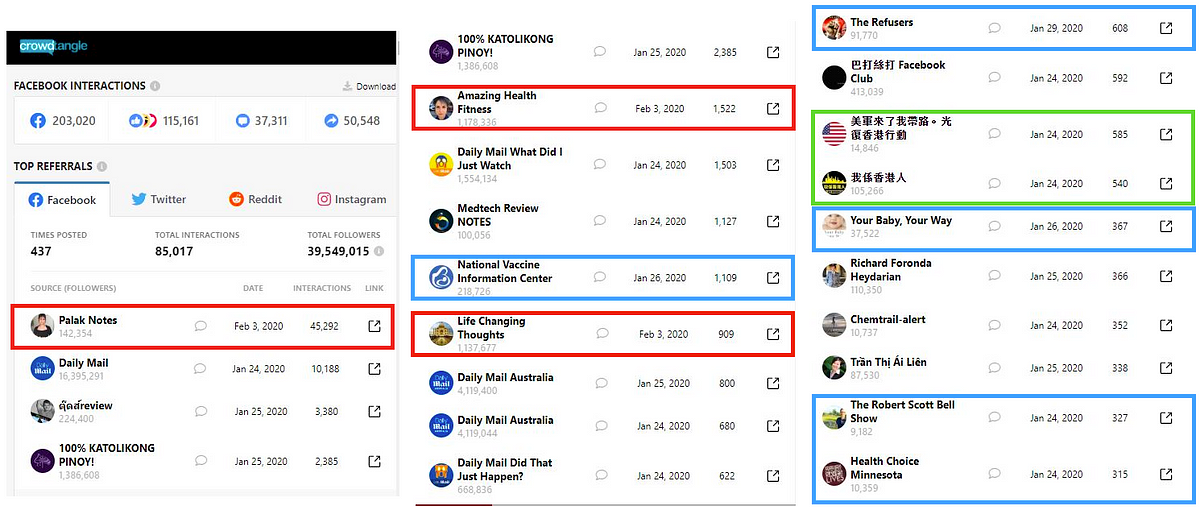
Following the Daily Mail article, the claim that the COVID-19 was released from the Wuhan biosafety lab was picked up by multiple fringe sites, including ZeroHedge, which compared the lab to the “Umbrella Corporation,” a fictional corporation from the Resident Evil films that created biological weapons under the guise of creating vaccines, and The Washington Times, which published two articles linking the lab to an alleged covert Chinese biowarfare program.
On January 30, Cotton posted a clip of himself mentioning the laboratory to his Facebook and Twitter pages. This was the first time he had specifically mentioned the lab, days after the Daily Mail and The Washington Times posted their stories; there was no indication, however, that he picked the conspiracy up from those sources.
The spread of an infodemic
Following a Washington Post article calling out Cotton for perpetuating debunked claims, the Arkansas senator doubled down on Twitter and laid out his list of theories, which he insisted were “hypotheses.” One theory suggested the virus emerged organically, while the other three involved the biosafety lab.
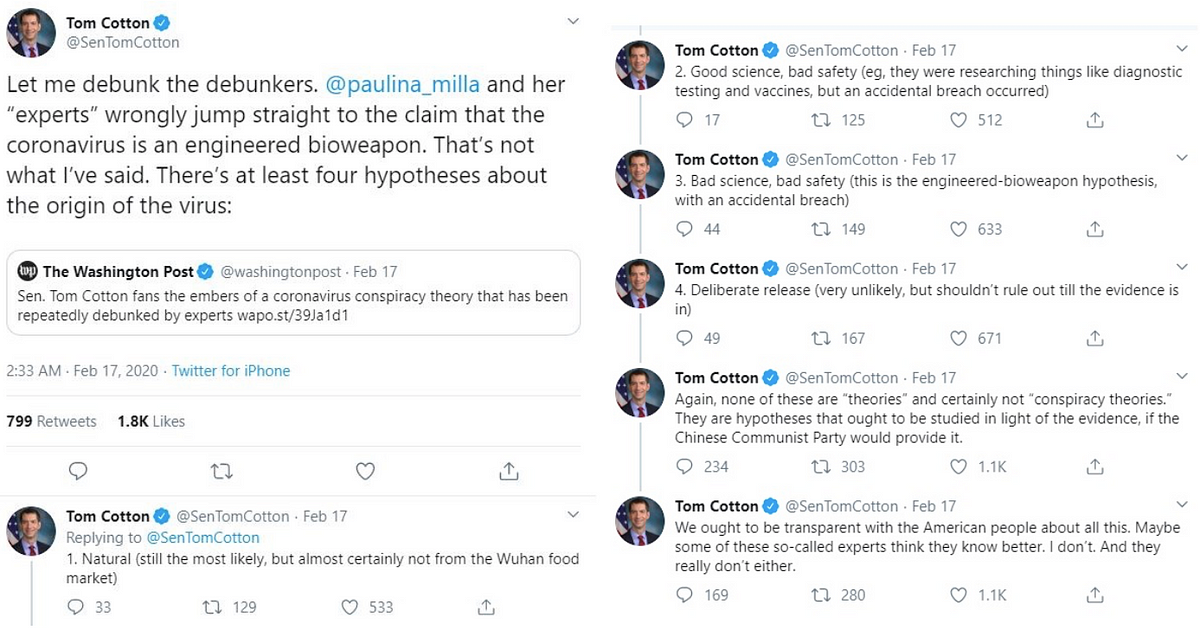
Cotton’s statements on COVID-19 come at a time when the WHO has declared misinformation and disinformation about the novel coronavirus particularly dangerous. The amplification of incorrect information, particularly by influential figures such as Cotton, diverts the attention of key decisionmakers, sows panic and fear, and makes the jobs of healthcare workers on the front lines significantly more difficult.
When conspiracies and public health intersect, the result is a particularly potent infodemic: one that hampers the crisis response to a global disease outbreak and puts lives at stake.
Update, May 7, 2020: In the seven weeks since this story was first published, the debate around the origins of the virus that causes COVID-19 continues among scientists, public health officials and policymakers. Last week, the New York Times reported on pressures from the White House to the US intelligence community to find evidence that virus came from a Chinese lab, as the Office of the Director of National Intelligence reaffirmed in a statement that the intelligence community “concurs with the wide scientific consensus that the COVID-19 virus was not man made or genetically modified,” and that it will continue to investigate whether the virus was formed naturally or was accidentally released from a lab. Meanwhile, the Washington Post reported on bat virus research conducted at the lab in Wuhan, while public health official Dr. Anthony Fauci told National Geographic that there is no scientific evidence to suggest the coronavirus was made in a Chinese lab. As research into its origins continues, we’ve edited this piece to refer to claims that the virus came from a lab as “unverified” rather than “debunked,” given the definitive finality of the latter term. We will continue to monitor this story as research into its origins progresses.
Tessa Knight is a Research Assistant, Southern Africa, with the Digital Forensic Research Lab.
Follow along for more in-depth analysis from our #DigitalSherlocks.

